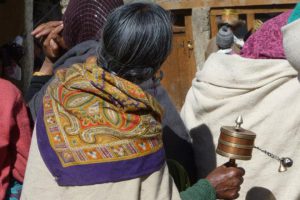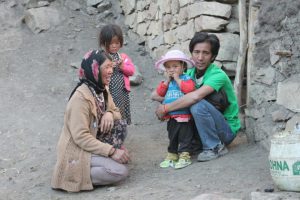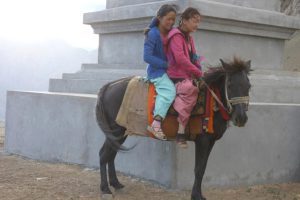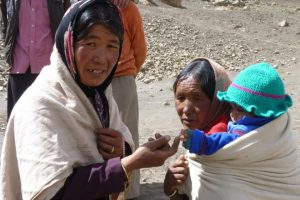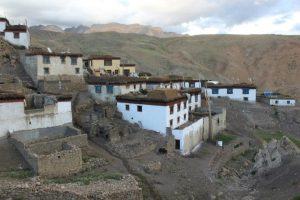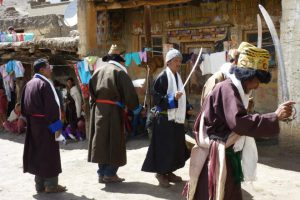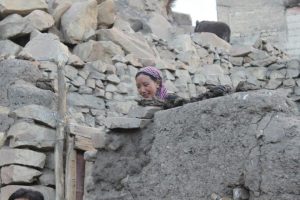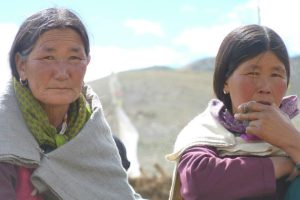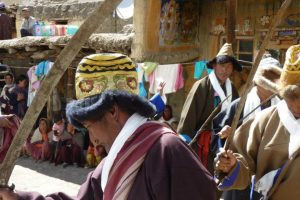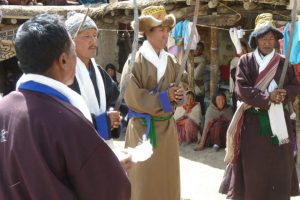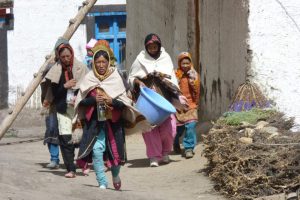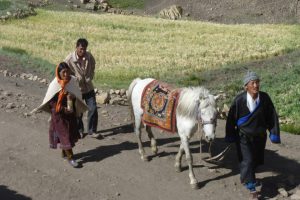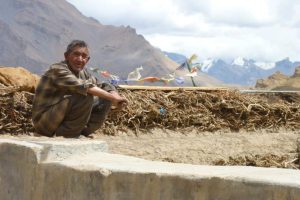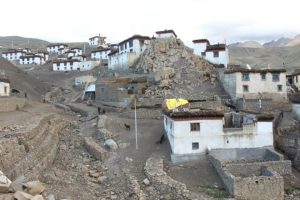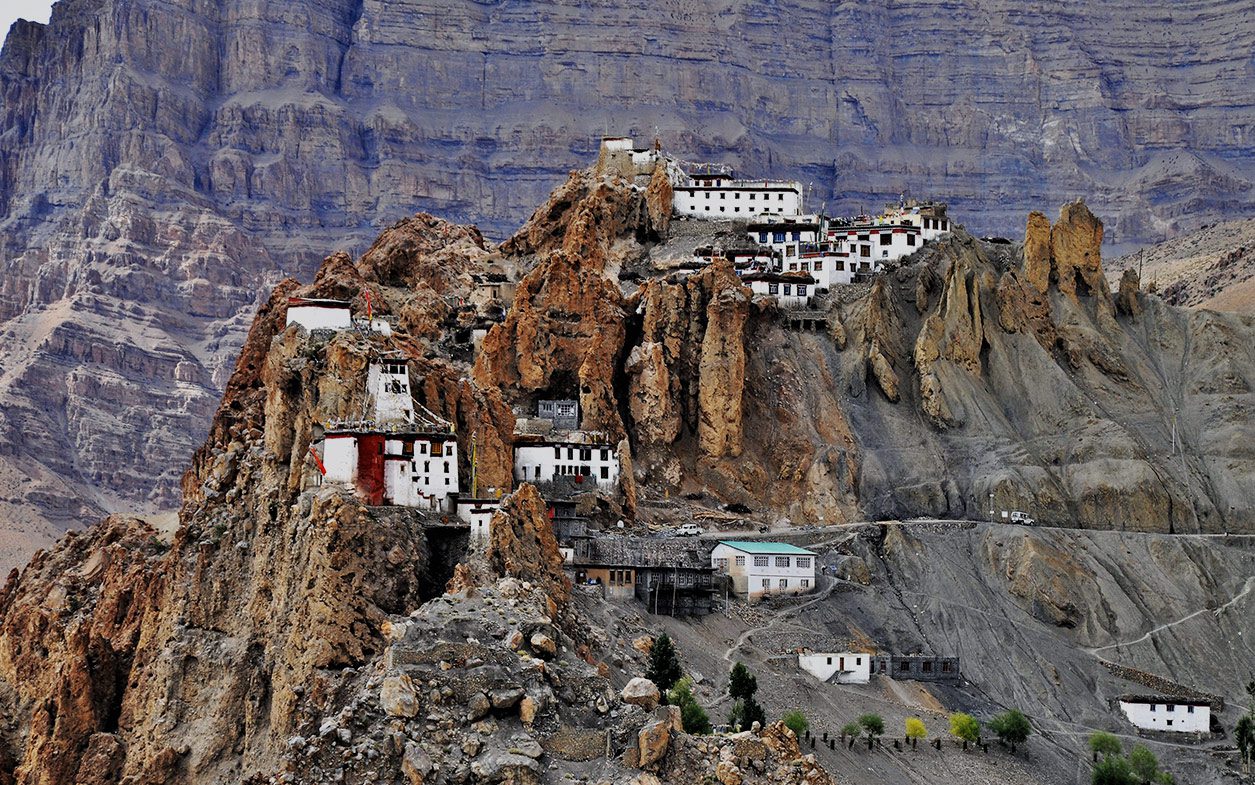
art of travel
Monthly Musing
Doing more with less in the Indian Himalayas
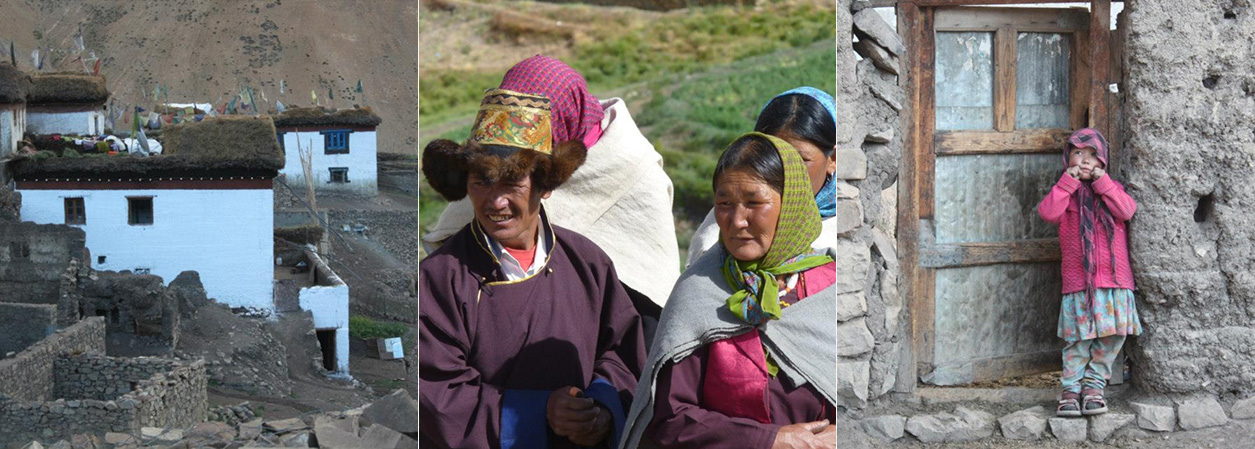
Our summer training programs have started after the pandemic. These are excellent educational experiences designed in-house to help our colleagues gain hands-on experience of destinations across India and much more. These programs coincide with the low season, allowing participants to enhance their skills with the idea of applying their first-hand knowledge during the high season to delight our guests.
Whilst a great amount of work goes into designing the courses to ensure that the participants challenge themselves through new learning experiences, we realised that in a tiny village called Demul in the Indian Himalayas, such training programs are a way of life.
Demul is one of Asia’s highest villages (14,200 feet/4400 metres) in the cold desert of Spiti in the Indian Himalayas and remains cut off from the rest of India for 7 months during winters. Five of our employees who went to volunteer for a CSR project of the company spent 3 nights at Demul during the Namkhan Festival. The Namkhan festival is wrapped around the agricultural practices of the village. The main objective of this small community festival is to appease and pray to the Gods for a good harvest. Namkhan provides an interesting insight into the relationship and significance of the village deity in the day-to-day life of the village.
Our volunteers came back after successfully building a Solar Bath for a Buddhist nunnery in the most challenging conditions and shared their learnings. We realised that teamwork, timelines, deadlines, trust, bonding, great planning, taking more responsibility, doing more with less, delegation of work, great allocation and use of resources, having a Plan B, acknowledging people’s efforts, and being creative and having fun at work that we touch upon in some of our summer training programs is a way of life in Demul.
For these hardworking mountain folks who prepare for the long winter ahead, timelines and deadlines are a must as they stock up for themselves and their livestock.
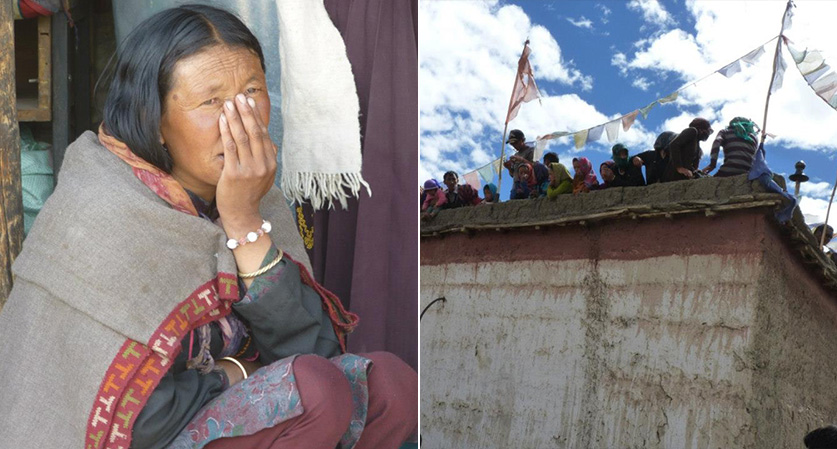
They grow peas and use the money for any spending during winter. Barley which they also grow is their staple; including barley wine. “Ghaas Ki Katai (cutting of grass from the meadows) for the livestock during winters is a critical activity. Each family is given a particular time slot and an amount of grass they can stock up for their livestock. Nothing more. Nothing Less. And they cannot afford to miss the deadline. The same applies to stocking up enough food for the family which they need to balance with their daily routine. One of the volunteers stayed with the accountant of Ecosphere; our local partner in the CSR initiative, who was in Demul for the Namkhan festival and to take time off for the winter preparations. He had relatives from his wife’s village who had come to help him. “They come over when we need them, and we go when they need us”. Now that’s trust, bonding, teamwork, and great planning. The residents of Demul that year were worried as there wasn’t enough grass in their meadows. “So, what happens to the livestock?” Our volunteers were told that depending on the grass they have managed to stock up, some of the livestock would be sent away to a relative’s village for the entire winter if it is not good enough to sustain. That’s such a simple plan B and you had someone willing to take more responsibility with more or less the same resources. Not surprising from these hardy mountain folks for whom doing more with less is a way of life. What was also interesting was the composition of families who would come to help from other villages. There would be 2-3 adult women, kids, and teenage girls. Our volunteers saw that while the kids played with the kids of their host family, the teenage girls helped in the kitchen and looked after the kids while the adults went out each morning to cut the grass from the meadows allotted to them. Now that’s another example of planning, smart delegation of work, and use of resources.
The volunteers asked a local who was threshing his barley about what happens when someone misses or extends the deadline allotted to them for collecting grass from the meadows. They were told that it is not a rarity, but people try their best not to. If a family does miss or extend their time, the village imposes a fine. They are allowed to continue but have to pay barley wine as a penalty. The village party with whatever barley wine they have managed to collect from defaulters. Now that’s being creative and having fun at work. This spirit of communal living of Demul is something that amazed us the most. Maybe communal living should be made a part of summer training programs too along with the rest.
Our Bridge the Knowledge Gap (BTKG) Tamil Nadu session kicks off on July 03. BTKG aims to empower, educate and share our collective knowledge with our colleagues. Members from various departments will undergo a 5-day in-house training session which will be followed by a two-week study tour where the participants will travel to various parts of Tamil Nadu to experience firsthand whatever they have been taught in the in-house session.
What’s New
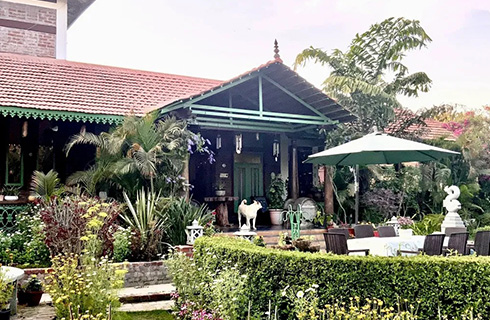
Shreevanam by Beejom, Bulandshahr
Shreevanam by Beejom is a brilliant example of sustainable architecture. Once a mono-cropped sugarcane field, Shreevanam is now a vibrant tropical food forest. Located in Bulandshahr just over an hour from Delhi, this three-bedroom farm stay is the brainchild of Aparna Rajagopal, a lawyer turned organic farmer and animal rescuer. The cuisine they offer is vegan, seasonal, nutritional, and incredibly diverse. Shreevanam has a cottage called Dogpur where they keep their rescued dogs, a cattery, a cow shed for rescued cattle, many bunnies, a duck, a geese herd, and several goats. Guests can also prepare their own vegan meal with the help of their farm chef, do some stargazing on a clear night or just swim in the small pool in their courtyard.
Weaving it into an itinerary
Routing: Delhi – Bulandshahr – Agra – Ramathra – Jaipur – Sariska – Delhi
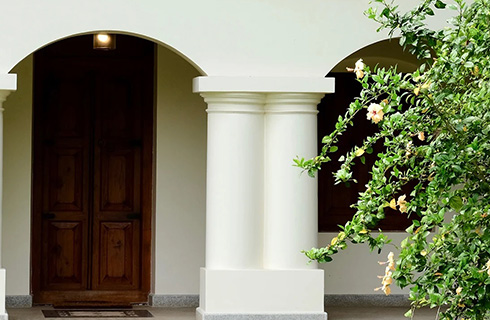
Nirvriti, Palakkad
The 19th century Nirvriti with its 2-bedrooms is home to Ria and Joseph who have lovingly restored it. For the couple, Nirvriti is a culmination of their travel experiences and experimenting with cuisines. After more than two decades of living and travelling across the globe, Joseph and his wife, Ria, along with their two children, Elia and Paul, opted to slow down and return to their home in Kerala. For the couple, food is a passion and they take joy in preparing a range of cuisines from Indian to Italian. Most of the ingredients used in their cooking are grown on their farm. The homestay experience goes beyond its serene ambience and good food. It promotes local businesses and encourages women on their entrepreneurial journey. The Nirvriti store works with local artisans, weavers, bakers, and others to curate a range of products. Guests can spend their time at Nirvriti by practicing yoga in the courtyard, taking a walk along the nearby river, visiting the 10-acre organic coconut farm, or visiting the nearby village with lunch at a small but reputed eatery, known solely for its rice and chicken curry. Evenings can be spent sitting in the courtyard, sipping on a drink, or watching a specially curated art performance of Kathakali or Mohiniyattam.
Weaving it into an itinerary
Routing: Kochi – Palakkad – Kozhikode- Kannur – Neeleshwar
Stories from India
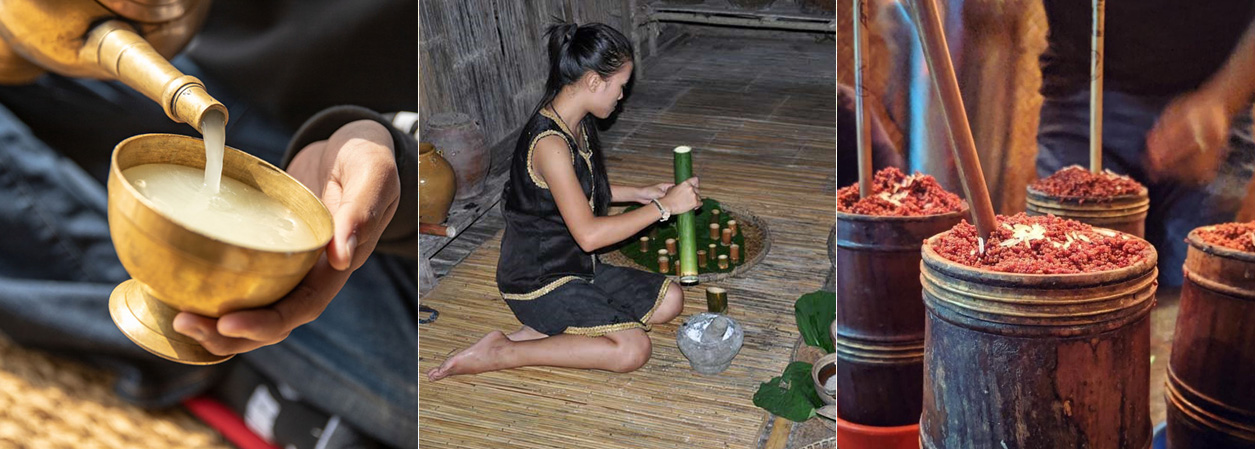
Happy High: Home brewed Rice Beer of Northeast India
Home brewed Rice Beer of Northeast India is an integral part of the culture and indigenous health care system of the region. There are 150 major tribes in Northeast India and every tribe has its own distinct fermented rice beer where they use locally available natural resources. The end result is a mind-boggling variety of home-brewed tipples, different in appearance, taste, aroma, and flavour. Variations can also be seen in the way it is served be it in bamboo pipes, mud utensils, banana leaf et al. The method of preparation differs from tribe to tribe and the brewing process takes anything from one week to three months. No preservatives are added to any variety of Northeast India’s home-brewed fermented rice beer, they hardly have a shelf life and are always consumed fresh. It is served on all social occasions from birth to marriage to death and also during festivals and religious rituals. The knowledge for preparing fermented rice beer is passed on from one generation to the next.
The process of preparation of rice beer begins with a starter cake. Usually, a local variety of gluten-ground rice is mixed with a number of plants with medicinal properties to make the starter cake. The variety of rice used also lends its own distinct flavour to the rice beer. The aroma of some of the varieties of rice beer of Northeast India has been found to be similar to Japanese sake. The process of making Zutho in Nagaland with sprouted rice grain is similar to European beers made with malt. Scientific studies by research institutions have revealed that the plants used in the starter cakes have medicinal values and the rice beer brewed

is rich in proteins, vitamins, amino, and antioxidant properties. It is also used by the tribes for treating fever, cold and cough, body aches, urinary tract infections and is also consumed by women to cure menstruation problems.
Here is an example of how one of the many varieties of fermented rice beers of Northeast India is brewed. Apong is the traditional rice beer of the Mising tribe of Assam. The starter cake of Apong is called Apop Pitha. For preparing Apop pitha, rice grains are soaked in water for 3-4 hours. Different plants are washed properly and ground together. A small amount of powdered old Apop pitha is also added to it. The mixture is made into an oval-shaped ball and left to dry. Cooked rice cooled and mixed with the Apop pitha is placed inside an earthen pot which is sealed with banana leaves. The pot is then smoked by placing it on a bamboo frame over the fireplace until the pot turns blackish, after 4- 5 days. The fermented mass is then mixed with a small amount of water and filtered to get Apong.
During their tour of Northeast India, we can organise a traditional Mising spread along with Mising Apong (home-brewed fermented rice beer) at a family restaurant in Majuli, Asia’s largest freshwater river island in Assam. Write to your relationship manager for more details.
Sustainability and Us

Travel Corporation India Ltd signs up to Travelife
We believe that it is the right of future generations to experience the beauty and majesty of the planet as we have had the privilege of seeing. With this in mind, we continue to liaise and associate ourselves with like-minded organisations to consciously bring sustainability into our products and work culture.
To further reinforce our commitment towards sustainability, we are happy to announce that Travel Corporation India Ltd (operating brands Sita, TCI, and Distant Frontiers) has signed up to Travelife, a leading international training, management, and certification programme for travel organisations that want to do business in a sustainable way.
Travelife offers travel companies a 3-stage approach towards sustainability and is recognised by the Global Sustainable Tourism Council (GSTC).
“As India’s leading DMC, our aim at Travel Corporation India is to make travel a meaningful activity and experience in social, ecological, and economic terms. With a dedicated Sustainability Action Plan in place and a committee to spearhead our endeavours in this area, we are excited to work along with Travelife now and use their knowledge, solutions, and tools to further implement positive change within our business and supply chain. Signing the Travelife certification programme will only further strengthen our commitment to ensuring a better travel product, a fairer tourist industry, and a more sustainable world,” said Dipak Deva, Managing Director, Travel Corporation India Ltd.
The organisation is taking steady strides towards making travel greener, smarter, developmental, and more responsible. We have learned that working together and exchanging best practices are crucial for advancing our efforts and those of others in the industry. Let us work together to build a future for tourism where responsible practices leading to sustainability is the only way of life.
Explore
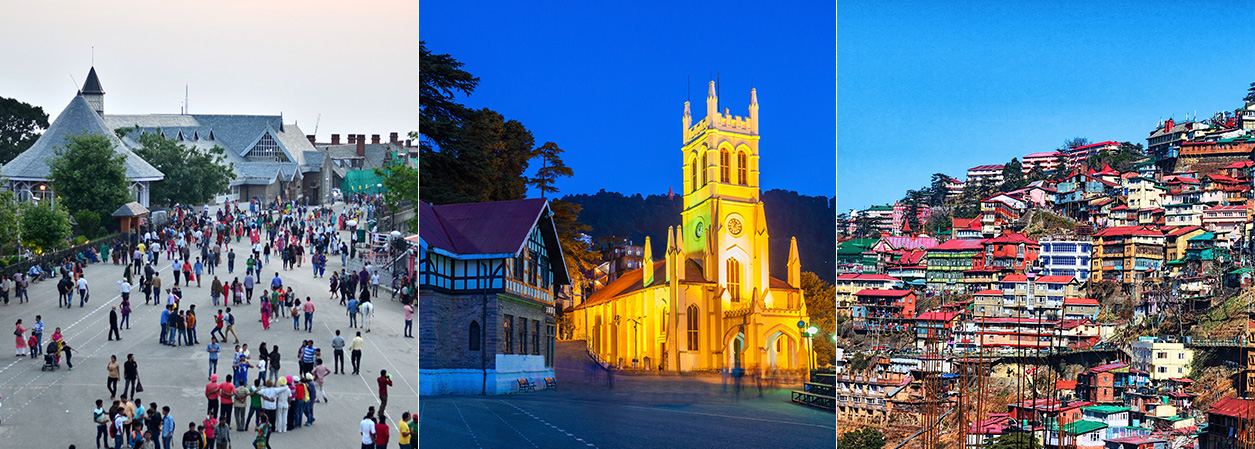
BEST WAY TO START A DAY IN SHIMLA
Like Rome and Bhopal in Central India, Shimla is built on 7 Hills. For guests staying at the Clarkes or Oberoi Cecil a terrific way to start the day is to go on a pre-breakfast walk around one of the 7 Hills – the Elysium Hill, which is very close to the touristy Mall road, yet surprisingly peaceful and quiet.
THE CURIOUS CASE OF LURGAN SAHIB
Cross the Lakkar Bazaar- famous for its handcrafted wooden toys and custom-made wooden items – to reach a very interesting stop. What is Auckland School today was once Belvedere, the house of Alexander Malcolm Jacob, the man who sold the Jacob Diamond, the fifth largest in the world to the Nizam of Hyderabad in 1891.
Sold as a slave to a Turk who educated him about the East – its life, language, art, literature, philosophy, and occultism, Alexander Malcolm Jacob came to Shimla in 1870 and started a business trading in precious gemstones and curios. Some of the wealthiest and most influential people in India were his clients. A handsome man, charming, magnetic, and mysterious, Alexander Malcolm Jacob was one of the most sought-after locals of Shimla – be it by the British or the Royals of India. The character Lurgan Sahib of Rudyard Kipling’s novel “Kim”, who lived in Simla, in a strange house piled with devilish masks was inspired by Alexander Malcom Jacob. It is said that his business went up in flames a few days after he sold the Jacob Diamond to the Nizam. Alexander Malcolm Jacob died penniless and was buried in Bombay.
THE ANGLO–AFGHAN WARS
From Auckland School continue walking to arrive at Chapslee, which was built in 1838 as the Lodge to the secretary of the British Governor General. In 1938, it was purchased by the King of Kapurthala of Punjab and is now run as a hotel by one of his descendants. The go-ahead of the Anglo-Afghan wars of the 19th century – which was a result of the struggle for power in Asia between England and Russia- was given from Chapslee. On prior notice and appointment from the owner, it is possible to go have a quick look from the inside.
MRS HAUKSBEE OF LONGWOOD
From Chapslee, cross the Rajkiya Kanya Mahavidyalaya (it is a Women’s College), or RKM as the locals call it, and arrive at Longwood. Longwood was originally a hotel and it was here Mrs. Elizabeth Burton lived. Her husband was a Major of the Skinner’s Horses- the cavalry regiment raised by the half-British, half-Indian James Skinner or Sikandar Sahib at Hansi in Haryana. The character of Mrs. Hauksbee of Rudyard Kipling’s – “Plain Tales of the Hills”
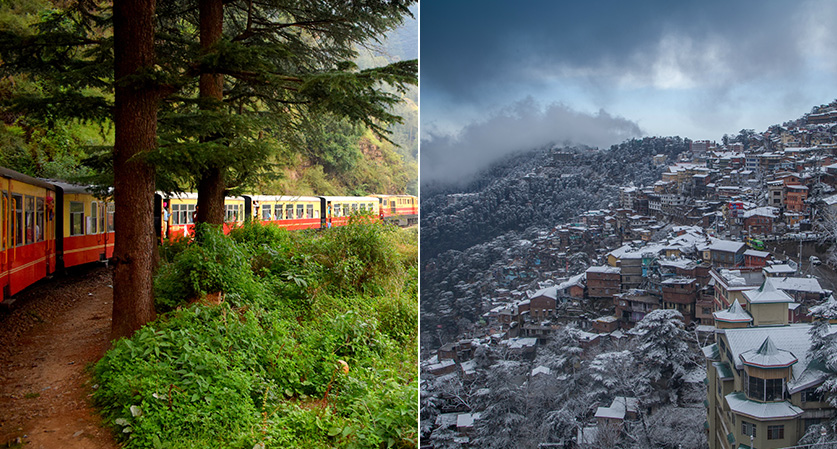
– “who had the wisdom of a serpent, the logical coherence of a man, the fearlessness of a child, and the triple intuition of a woman – was based on Elizabeth. The entire area is now known as Longwood.
SNOWDON HOSPITAL
Behind Longwood, on a distant hill, is the Snowdon Hospital named after the highest mountain in Wales. The old structure which was lost to a fire was once occupied by Lord Kitchener, the British Viceroy. In 1903, Lord Kitchener gave one of his most famous ballroom parties here.
STERLING CASTLE
From Longwood, continue walking and stop briefly to hear the story of Sterling Castle, one of the first 3 houses of Shimla built in 1833. British Viceroy Lord Auckland’s sister Emily Eden wrote of it in her diary in 1839 as “a bleak house that nobody would live in and that in general is struck by lightning once in a year”. But Sterling Castle housed many eminent people from the British Raj, changed many hands, and also served as a hostel for Tibetan refugee children after the Chinese invasion of Tibet.
THE MAN WHO MADE SHIMLA-KALKA RAILWAY
Longwood onwards the views are brilliant. Harrington the next stop is a quiet neighbourhood that now houses the Judges of the High Court of Himachal Pradesh. It was here the Chief Engineer of Kalka Shimla Railway H.S. Harrington once lived. The houses of the Judges are built on what was once the lawn of Harrington’s residence. On the left of Harrington’s residence is a water tank. It was once an ice pit (one of the many in Shimla) during the British Raj. During the winters, small earthen pots filled with water were placed in an open field, and in the morning the coating of ice formed in the cold temperature of the night was collected and stored in such ice pits for the summer.
THE COTTAGE OUT OF A FAIRY TALE
A little ahead of Harrington; hidden in a beautiful stretch of Deodar, Oak, and Rhododendron trees is Northwood which belonged to Mrs Hermione Montagu, the last British Lady who was born, lived, and died in Shimla. Northwood looks like a cottage straight out of a fairy tale and Mrs Montagu lived here with 15 cats and 15 dogs until her demise in 1985 at the age of 93. She was featured in many writings on colonial India, including “Freedom at Midnight” by Dominique Lapierre, and several documentaries.
THE VILLAGE OF BHARARI
This walk ends at Bharari- one of the 15 villages which Charles Pratt Kennedy, the British Political Agent and founder of Shimla had demarcated as its boundary in the early 19th century. Shimla then was a settlement of only fifteen hamlets. Even today, Bharari marks the end of the Shimla Municipal Corporation.
Ahead of Bharari is another beautiful short stretch of forest. Our car will be waiting here to drive guests back to the lift which will take them up to Mall Road.
GOOD TO KNOW
- Duration: 2-3 hrs. Ideal for FITs and Small Groups (6-8 pax)
- Easy, leisurely paced walk, a few downhill descents also easy, uneven surface
- A good pair of walking shoes is a must
- Bring your binoculars if interested in birds
- Vehicle required
- Total kms covered: 3 kms
- This walk can also be done in the afternoon too when guests arrive Shimla from Chandigarh by surface
Write to your relationship manager to know more about our Walking Tours in Shimla.
Festivals to Look Out For
Phyang Tsedup Festival, Leh & Ladakh
15th to 16th July, 2023
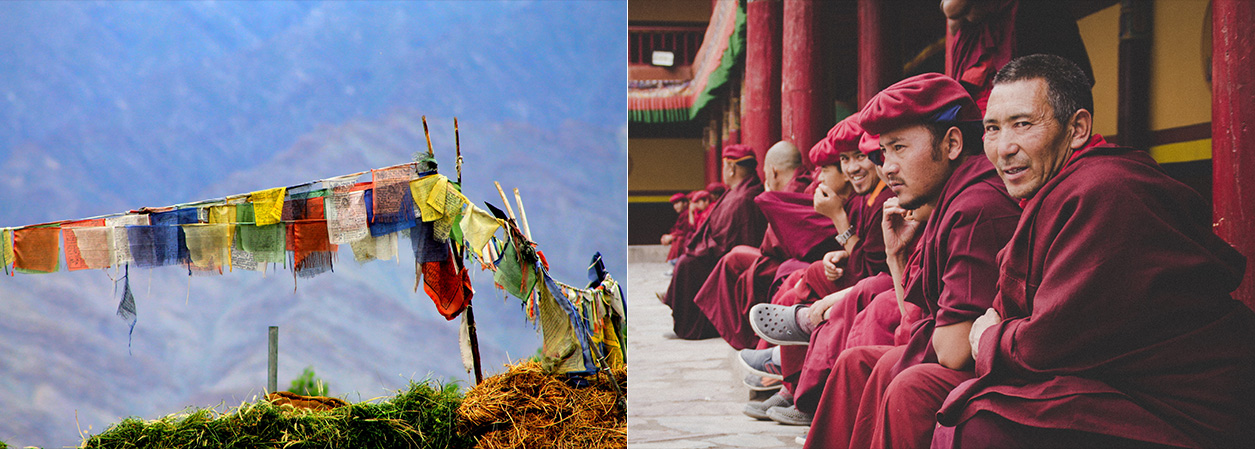
Phyang Tsedup festival is held annually at the Monastery of Phyang and goes on for 2 days. On the day of the Tsedup, special prayers are performed. The sacred mask dance of monks in rich silk costumes is the prime attraction. Along with the mask dances, dramas or ‘Chhams’ are the main part of the festival.
Stay at: Dolkhar, Leh
Half an hour from the monastery sits the beautiful Dolkhar – a boutique property with 7 Villas built around an apricot and apple orchard. Each of the villas is built across two levels – living and dining areas on the lower level and bedrooms on the upper level. From food made using special ingredients to the construction materials used, everything represents the ethos of the Ladakh region.
Picture Gallery
Namkhan Festival, Demul
The Namkhan festival of Demul is wrapped around the agricultural practices of the village. The main objective of this small community festival is to appease and pray to the Gods for a good harvest. Namkhan provides an interesting insight into the relationship and significance of the village deity in the day-to-day life of the village.
RESOURCES
SITE LINKS
CONTACT US
+ 91 (124) 4563000
Tower B, Delta Square, M.G. Road, Sector 25, Gurgaon - 122001, Haryana, National Capital Region of Delhi, India


